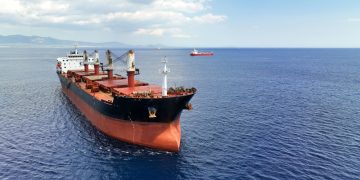In an exclusive interview to SAFETY4SEA, Petar Modev, Head of Ship Inspection at the UK P&I Club, emphasizes that preventing and containing fires caused by lithium-ion batteries is not just a challenge for the maritime sector.
It is a complex, interconnected issue requiring collaboration among multiple stakeholders across the supply chain. This cooperation is essential to ensure that stringent safety protocols are implemented at every stage. Given the risks associated with lithium-ion fires, operators are advised to consider comprehensive fire training for all crew members. While hands-on training is ideal, virtual simulations and online training platforms offer an accessible alternative to enhance preparedness.
SAFETY4SEA: What should be industry’s top priorities for the upcoming years for enhanced fire safety onboard?
Petar Modev: With the profile of some cargoes changing, particularly the carriage of products containing lithium-ion batteries, it’s important that the industry continues to develop strategies for mitigating and addressing these new risks. We are seeing a concerted effort to do this but at a time when shipping companies are facing a myriad of challenges, enhancing fire safety protocols needs to stay top of mind. Effective crew training is the first line of defence against li-ion battery fires and is an essential tool for building crew member’s confidence in managing this growing and opaque threat. Alongside implementing standardised advanced training programmes, we encourage ship owners and operators to re-evaluate their approaches to fire detection and equipment as part of a revised strategy overall. The prevention and containment of fires caused by lithium-ion batteries isn’t just an issue for the maritime sector. It is a complex and interconnected issue that involves collaboration between multiple stakeholders throughout the supply chain so that stringent safety protocols can be implemented from production to the destination port and beyond. Although it is important to implement change on a regulatory and stakeholder level, it is also vital that the industry adopts a more integrated approach in order to achieve the most impactful change.
S4S: What advancements in fire detection technology are most promising for early detection of li-ion battery fires?
P.M.: The challenging characteristics of fires caused by large li-ion batteries such as the ones in electric vehicles (EVs) are well documented, but there are tools available to help detect fires early. We have been proud to support Lloyd’s Register’s Safetytech Accelerator’s Cargo Fires and Loss Innovation Initiative (CFLII). This programme identifies a range of innovations in fire detection and safety practices which will help to mitigate the impact of fires onboard. These include a variety of cutting edge technologies designed to detect fires both inside a cargo hold and on deck.
S4S: Can you elaborate on the firefighting strategies that are most effective in tackling li-ion battery fires on ships?
P.M.: A ‘Fixed Fire-Extinguishing System First’ defensive strategy that is focused on early detection and containment is the most effective for tackling lithium-ion battery fires. Crews’ tactics and equipment need to reflect this. For example, as li:ion battery fires will sustain themselves, vessels need systems that use intuitive technologies to identify fires quicky, as well as suppression systems with additional capacity (foam, CO2, etc.) to control outbreaks. With regards to crew members, we must ensure that they are provided with effective training that will establish a robust line of defence against li-ion battery fires on vessels. This training must also be extended to onshore teams, to build their knowledge and change approaches to supporting offshore crew members in managing li-ion fires.
S4S: What specific training should seafarers receive to better handle the unique challenges posed by li-ion battery fires?
P.M.: More intensive scenario-based simulation training is particularly effective. Usually, advanced fire training is just delivered to senior crew members, but considering the impact of li-ion fires it is recommended that operators consider comprehensive fire training for all crew. Although physical training is the ideal, using virtual simulations and online training platforms is a way to make this more accessible. This takes the theory ‘off the page’ and enables crew to familiarise themselves with what a live incident would be like. For example in June 2024, the UK P&I Club, in association with React and Simwave, delivered a ‘Modern Fire Risk’ training workshop from Simwave’s Maritime Training Centre of Excellence in Rotterdam. The programme combined classroom and simulation-based learning for superintendents, HSEQ professionals and technical managers in shipping companies that operate car carriers or container ships. Onshore teams should also be included in training scenarios to build their knowledge and change approaches to supporting crew in managing li-ion fires. The shoreside emergency response teams need to be ready to assist with cargo stowage information as well as being able to help with fire-fighting strategies options and provide supplementary guidance on aspects, such as weather routing and forecasts. Building onshore capabilities also applies to upskilling firefighting crews onshore, particularly those working in ports. Developing good collaboration between the shipping company’s emergency response teams and the shoreside firefighting services to improve processes will be beneficial.
S4S: How can we create the right mindset, engage our people and reinforce the right behaviours for strengthening safety culture onboard ships?
P.M.: Creating a strong safety culture takes time and consistency. It should be recognised as a strategic priority and implemented across all touch points of operations and crew interactions starting from training and inductions and extending to everyday practices onboard. If we look at industries like aviation with particularly stringent safety standards, there is still an opportunity to collectively improve and leverage new processes and technologies to safeguard crew, cargo and operations.
S4S: Are there any upcoming initiatives or collaborations at UK P&I aimed at improving fire safety related to li-ion batteries?
P.M.: The UK P&I Club is a member of the Vehicle Carrier Safety Forum. Recently, they published their first good practices guidelines on ‘Common Guidance on the loading and presentation of vehicles’. This guidance was based on shared practices and was supported by ourselves, the International Group of P&I Clubs (IG), the International Chamber of Shipping and the TT Club. The comprehensive guidance advises vessel operators and supply chain partners on the safety aspects of booking, planning, and presenting electric and large-battery hybrid vehicles at port terminals. This resource also includes content regarding loading, stowage and monitoring vessels during a voyage. The UK P&I Club is also a co-sponsor of the Cargo Incident Notification System’s (CINS) ‘Lithium Batteries in Containers Guidelines.’ This initiative encourages collaboration between shippers and stakeholders on the handling, booking and providing storage and transportation of cargo containing li-ion batteries, which includes stringent planning, documentation, hazard detection training and fire management.
S4S: What is your key message to industry stakeholders with regards to li-ion battery fire risks?
P.M.: While work to update standardised training regulations continues, we urge shipping companies to look beyond compliance and use the resources available now equip crews and onshore teams with the capabilities to manage these risks. Simultaneously, the industry’s collective work with supply chain partners to agree a framework for putting procedural measures in place is just as critical as after all, prevention is better than the cure.
The views presented are only those of the authors and do not necessarily reflect those of SAFETY4SEA and are for information sharing and discussion purposes only.


































































